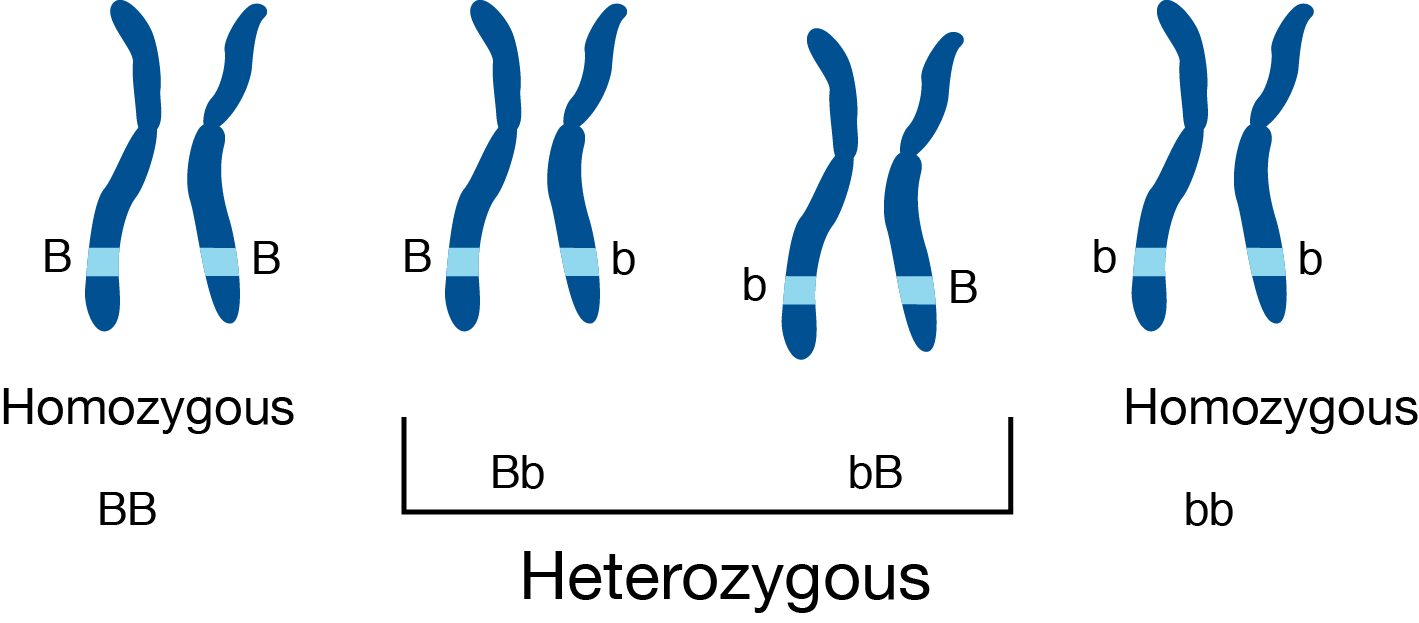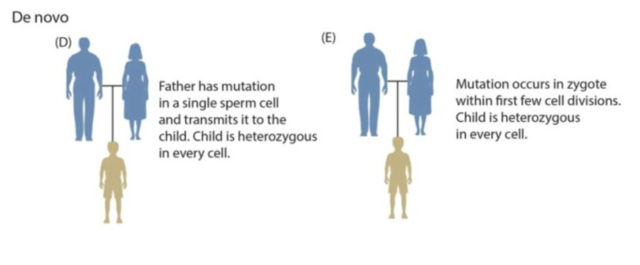Difference Between Homozygous and Heterozygous
The homozygous condition is when two alleles are both the same for a particular gene. The heterozygous condition is when two alleles are different for a particular gene.

What is Homozygous?
Definition:
Homozygous is a state in which a particular gene is present as two alleles that are the same, either both are recessive or both are dominant. In a homozygote individual, the recessive traits are phenotypically expressed because there is no dominant allele to block the expression of the gene, assuming it follows Mendelian rules.
Examples of homozygous genotypes:
If we use the letter A to represent a dominant allele and a to represent a recessive allele, then the genotype of a homozygous individual could be either AA or aa.
Examples from Mendel’s work:
Mendel described homozygous plants as being true-breeding plants since genetics were not well understood at the time. A true-breeding plant always produced the exact same traits in the offspring which meant that the factors were the same. Later scientists understood this to mean that the factors were the alleles, the forms of the gene.
Diseases or conditions that occur in the homozygous condition:
There are many diseases in humans that are caused by recessive alleles. In these cases, the disease is only expressed in the homozygous form; an example is steroid-resistant nephrotic syndrome (SRNS) which is caused by a recessive mutation in the NPHS2 gene in about ¼ of cases. The sickle-cell trait only causes sickle-cell anemia and illness when present in the homozygous condition since the allele is recessive.

What is Heterozygous?
Definition:
Heterozygous is the state in which each of the two alleles of a gene is different; one is a dominant allele while the other is a recessive allele. In Mendelian genetics, a dominant allele is always expressed in both the homozygous and heterozygous condition, but a recessive allele is not expressed if present as an allele in the heterozygous state.
Examples of heterozygous genotypes:
If A is used to indicate dominance, and a is used to indicate recessiveness, then the genotype of a heterozygote would be given as Aa. The heterozygous condition means that alleles can be hidden and carried but may not be phenotypically expressed depending on the genotype of the offspring.
Examples from Mendel’s work:
Mendel called plants that we now know are heterozygotes, hybrids because he recognized that the plant was carrying two different factors, now known as two different alleles. This was how a plant that had purple flowers had some offspring with white flowers even though two plants with purple flowers were crossed. This occurred because the allele for white flower color was recessive and was inherited from both parents when both parents were heterozygotes.
Diseases or conditions that occur in the heterozygous condition:
The sickle-cell trait can occur in the heterozygous condition; in this form, the allele for sickle-cell is an advantage because it protects people from malaria, but at the same time does not make them ill with sickle-cell. This condition is called a heterozygote advantage and has been proposed as the reason that the trait persists in the human population. Diseases caused by dominant alleles such as Huntington’s disease can occur in the heterozygous condition since the allele is an autosomal dominant allele, and thus you only need to inherit one allele for the disease to actually get sick.
Difference between Homozygous and Heterozygous?
Definition
Homozygous is the condition in which there are two alleles for a gene, both of which are exactly the same, either both alleles are dominant or both are recessive. Heterozygous is the condition in which there is one dominant and one recessive allele for a gene.
How many forms it can occur in (assuming Mendelian genetics)
The homozygous condition can occur in two forms. The heterozygous condition can only occur in one form.
Potential genotypes
Assuming A is dominant and a is recessive, in the homozygous condition the genotypes can be either AA or aa. In the heterozygous condition, the genotype can be Aa.
Mendel’s term
Mendel’s term for homozygous was true-breeding and for heterozygous the term was hybrid.
Mendelian genetics
In the case of homozygotes, an allele is always expressed phenotypically because it is present on both chromosomes. In the case of heterozygotes, an allele is not always phenotypically expressed unless it is dominant, and it can be carried as a recessive allele that is not expressed.
Diseases or conditions
The homozygous condition is responsible for about 25 percent of cases of steroid-resistant nephrotic syndrome (SRNS) and is the state in which the alleles for sickle-cell anemia are expressed. The heterozygous condition can be an advantage in the case of sickle-cell which in the heterozygote form protects a person from malaria; some diseases like Huntington’s disease are expressed even in the heterozygous form.
Table comparing Homozygous and Heterozygous

Summary of Homozygous Vs. Heterozygous
- Homozygous and heterozygous are both terms used to describe the alleles making up a particular gene.
- Homozygous alleles are always the same and can be present either as two dominant alleles or as two recessive alleles.
- Heterozygous condition refers to the state in which each allele for a gene is different and in which one allele is recessive while the other is dominant.
- Diseases that occur in the homozygous condition include sickle-cell anemia and some cases of steroid-resistant nephrotic syndrome.
- An illness that can occur in the heterozygous condition includes Huntington’s disease.
- Difference Between Rumination and Regurgitation - June 13, 2024
- Difference Between Pyelectasis and Hydronephrosis - June 4, 2024
- Difference Between Cellulitis and Erysipelas - June 1, 2024
Search DifferenceBetween.net :
Leave a Response
References :
[0]Image credit: https://upload.wikimedia.org/wikipedia/commons/thumb/9/92/De_novo_mutations.png/640px-De_novo_mutations.png
[1]Image credit: https://commons.wikimedia.org/wiki/File:Heterozygous.jpg
[2]Editors of Encyclopedia Britannica. "Sickle-cell anemia". Encyclopedia Britannica, 2019, https://www.britannica.com/science/sickle-cell-anemia
[3]Hildebrandt, Friedhelm, et al. "A systematic approach to mapping recessive disease genes in individuals from outbred populations." PLoS genetics 5.1 (2009): e1000353.
[4]US Library of Medicine. "Huntington disease". National Institutes of Health, 2019, https://ghr.nlm.nih.gov/condition/huntington-disease
